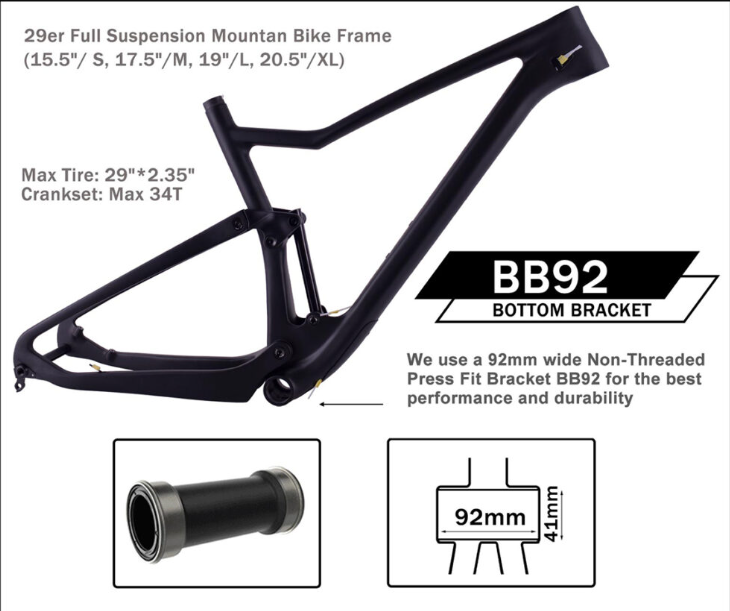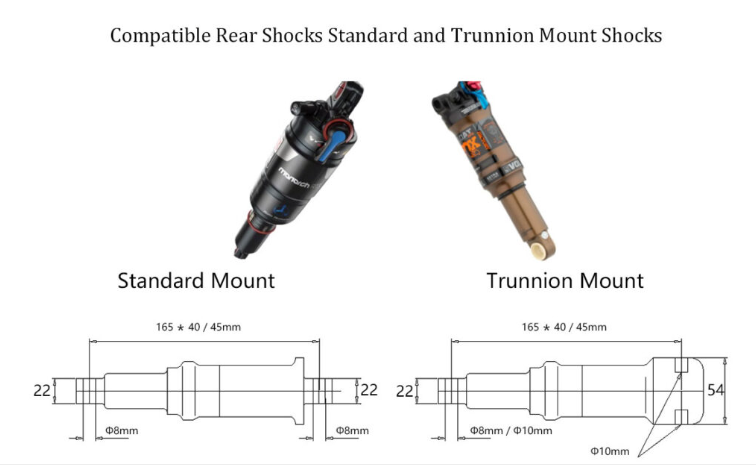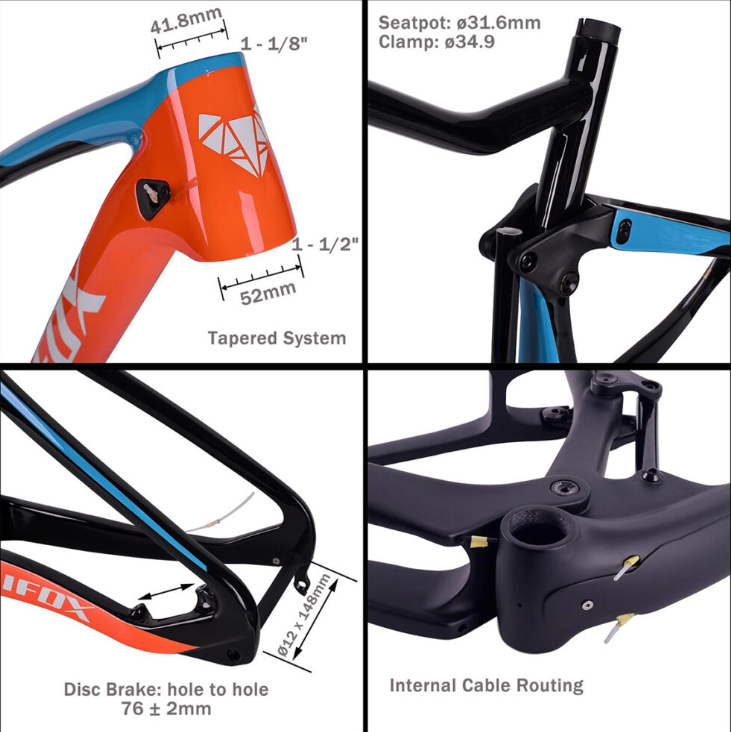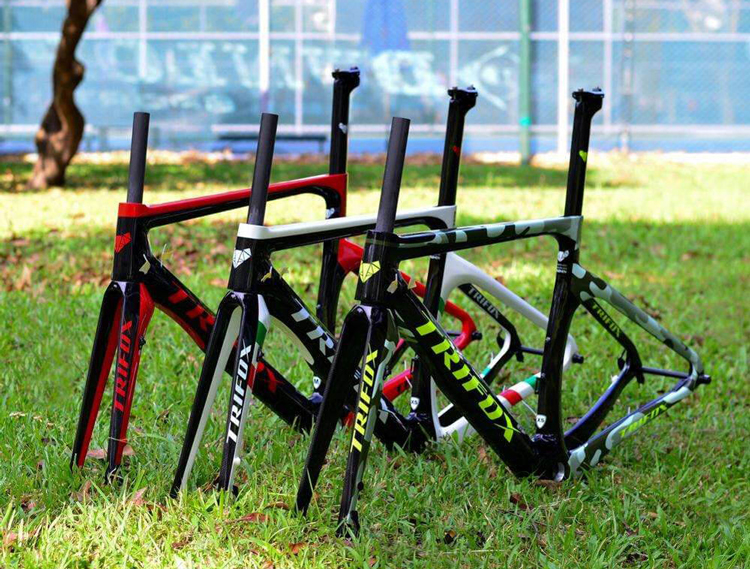The Trifox is only available with a Full Suspension Carbon MTB Frame, which partly explains the high price tag. Cons: Great geometry; balanced suspension; composed when it counts
That frame is certainly the talking point here. The incredible paint job and full suspension design make it one of the most instantly head-turning bikes at the trailhead.
But just how well does this fancy frame perform with cheaper parts bolted to it? Will they hold it back or is the spec well enough considered, avoiding it being an issue? Read on to find out.
First, the cross-country frame that is just like Scott Spark can be installed with a 100 mm shock with 165x40mm, but if you install this with a 165x45mm shock. You can build it up with 115 mm of travel. Shock mounting hardware is included, and it is held in place by this spacer. At the bottom, you have room for a trunion mount shock. Two bolts are included in the package in case you are going for a trunnion-mount shock, this also is a line for the remote if you install this as a cross-country bike. Torque value for these bolts or pivots is written right on them, which is very convenient. They’re also fairly low, 12 nm being only for this main rocker pivot. The seatstay bolts are installed from the inside, 10 nm again. We should have called them the flex stays, because that’s the design of the swing arm of this bike, just like the new Stumpjumper or the new Transition Spur. What that means is that you have one pivot point down here, and a second pivot point connecting to your rocker, but you don’t have the third pivot right here and the seatstays have to flex by a few degrees as the suspension moves up and down. Talking about this little rocker, this is made out of aluminum, on fancy materials here, sometimes it’s made out of two pieces. One on each side connecting the shock to the rest of the swing arm. A rear brake caliper is a post-mount, it’s going to be installed here inside the rear triangle, and the hose is going to come out on the inside, that’s a pretty common design there today. Equipped with a Trunnion rear shock mount, bring us the most efficient pedaling design, asymmetric design, we deliberately offset the position of the rear shock, so that the structure of the bicycle can be smooth, and the carbon fiber can perfectly achieve one Linear structure, and when the rear shock absorber is locked, the cable movement space on the left will be reserved, so that the down tube can be kept unblocked through the rear shock absorber to the main turning point.


Our boost frame can fit a maximum 2.35″ size of tire. The boost design can increase the space of the chainstay, which can use larger and more speedy flywheels, the design of frog legs is more facilitate, and it also increases the elasticity of the rear fork, more shock absorption, and more comfortable. There is quite a bit more room around the tire up top here on seatstays. Boost gives a 148 x 12 mm spacing which allows for the hub flanges to be further apart which gives a potentially stronger and stiffer rear wheel, and Boost 148 mm spacing in the rear, the Thru axle is provided as well, and gets a derailleur hanger that gets installed fairly easily, it doesn’t come installed from the factory. It is held in place by this tiny bot, and going to be secured in place with the Thru axle on the drive side you’re going to see the routing for derailleur cable, it’s coming out right on top of the chainstays which is something that I like, it works well with both Shimano and SRAM drivetrains. The BB68/PF92 bottom bracket it’s a press fit, not a thread. The seat tube, you already have a line coming up here for internally routed droppers, this is a 34.9 mm seat clamp which is not provided 31.6 mm diameter seatpost , because of this main pivot over here, you don’t have a lot of room to insert your dropper in the frame. Keep in mind that every dropper has an actuator at the end of about 2 cm. Frame at the bottom, this is not only downtube protection, but underneath here, if you use a 2.5 mm hex/Allen, you can slide the protection back, and underneath you have a holder for DI2 battery downtube.

Thankfully though, the brand does offer it in four frame sizes (small to extra-large) with some decent geometry across the board. A slack 68.5-degree head angle should help provide a decent amount of stability at high speeds. To help create a nice, efficient seated climbing position, the Trifox’s effective seat tube angle is steep at 74.7 degrees. In short, this means each frame size has specifically tuned kinematics (that means slightly different leverage ratios, levels of anti-squat and anti-rise, as well as differing axle paths). As part of the brand’s Proportional Response concept, it is just the suspension kinematics that is tweaked as you change the frame size, but the effective chainstay length is no different. While all four sizes had an effective chainstay length of 438 mm, again kind of standard for a bike that is supposed to be good at pedaling. There’s plenty of room in the cockpit without ever feeling as though you’re being stretched out or forced down too far over the front, thanks in part to that 570 mm–650 mm effective top tube and steep 74.7degree seat angle.

The tubes are subtly shaped and curved, with additional reinforcement added to the top and seat tube junction, while the top and down tubes meet nice and early in a bid to help bolster strength at the head tube junction. There’s no seatstay bridge, ensuring masses of mud clearance. Driving the rear shock is a one-piece forged rocker link that’s designed to be both stiff and strong, with the aim of ridding any unwanted flex from the suspension system and keeping the back end of the bike working as smoothly as possible. In a similar vein, the 74.7-degree seat angle (measured at your preferred pedaling height) is one of the steepest compared to its counterparts, suggesting a comfy seated position when winching up steep climbs. That raked-out head angle, along with the 412.9–487 mm of reach, contributes to a lengthy 680.4–762.2 mm front center (the horizontal measurement from the center of the bottom bracket to the center of the front axle), which will no doubt contribute to stability at higher speeds.
The 438 mm rear center is shorter than many other bikes with similar intentions. While this should work well for smaller riders on the more compact frame sizes, taller riders on the bigger frames may find their weight too far over the rear wheel at times (this is a large part of the reason some brands will now grow the chainstay measurement as frame size increases). The short back end and taut frame also make it an easy bike to flick about or loft the front wheel into the air with little effort from the rider. That means chucking it around and making shapes as you work your way down the trail comes really naturally to the TRIFOX MFM100, and you don’t need to expend too much extra energy if you’re keen on bouncing your way down the trail, getting sideways at every opportunity. These instances were few and far between on the medium frame, but taller riders on bigger bikes may notice this more frequently. And that’s not to say the short back end holds the Marin back, but a slightly longer back end (maybe just on the bigger frames) would simply make it even better.
This bike will take on any trail you’re brave enough to throw it down. A few minor spec changes would really elevate its performance. It’s easy to spot the stretched-out geometry, relaxed head angle, and burly build. Look closer at the spec sheet, though, and you may need to do a double take. That’s because it’s jam-packed with the great kit, yet still comes in at a scarcely believable price (certainly when compared to its closest rivals).




















































































